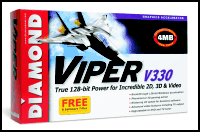


"3D games is were the Viper330 really shines. At both 640x480 and 800x600 it aced the 3D Graphics WinMark 98 with scores usually limited to Pentium-II systems."

Diamond Viper V330 4mb PCI
![]()
 Diamond once again packs the Viper in their ambiguous oversized box, along with a wealth of CD-ROMs including full versions of F22 Raptor and Moto Racer. No manual is included, and installation instructions are simply printed on the cardboard CD sleeve. The board features composite and S-Video outputs for hooking your computer up to a television, though no video capture abilities are included. The hardware layout is based on nVidia�s reference board and is nicely constructed. A flash BIOS is a welcome sight as are two feature connectors for future add-ons such as a DVD video decoder and TV tuner.
Diamond once again packs the Viper in their ambiguous oversized box, along with a wealth of CD-ROMs including full versions of F22 Raptor and Moto Racer. No manual is included, and installation instructions are simply printed on the cardboard CD sleeve. The board features composite and S-Video outputs for hooking your computer up to a television, though no video capture abilities are included. The hardware layout is based on nVidia�s reference board and is nicely constructed. A flash BIOS is a welcome sight as are two feature connectors for future add-ons such as a DVD video decoder and TV tuner.
DOS performance was in line with other Riva boards, providing adequate though not exceptional framerates in Quake and Duke Nukem. No utility is included to change VESA refresh rates, so you�re stuck with the default of 60Hz or lower for all resolutions. Drivers are provided for Windows 3.1, 95, NT 3.5 and 4.0, though OS/2 users are out of luck.
Installation in Windows 95 was straightforward, though it is important to remember to completely remove your previous video card drivers and utilities before installation. The Viper�s drivers are identical in feature set to the Stealth S220�s, and while they were ideal for the lower end card we would have liked to see more comprehensive abilities for the Viper. The built-in 230Mhz RAMDAC allows for a maximum resolution of 100Hz in true color at 1024x768, which is ideal for most users� needs. 1600x1200 is available with 256 colors at 85Hz.
The drivers may not have the expanded options of others, but they certainly were fast pulling in the best 2D score in the roundup. Diamond is known for tweaking their drivers to the Nth degree, and it really pays off here. Perfectly suited in performance to high-end applications such as CorelDRAW and PhotoShop, professionals are only restricted by it�s 4mb of on-board video RAM which limits true-color resolutions to 1152x864.
The Riva128 graphics processor produced admirably good MPEG playback, even when using low-quality captures. Smooth flowing at full screen, colors were bright and edges were well defined.
 3D games is where the Viper330 really shines. At both 640x480 and 800x600 it aced the 3D Graphics WinMark 98 with scores usually limited to Pentium-II systems. Jedi Knight was exceptionally fast, though as with the other Riva128 boards it didn�t feel as smooth as it should have. At the time of testing there were only Alpha OpenGL drivers available for the Viper, and they wouldn�t install on our testbed system. Preliminary testing using the new Beta drivers shows much potential for Riva boards, and Quake II players in particular.
3D games is where the Viper330 really shines. At both 640x480 and 800x600 it aced the 3D Graphics WinMark 98 with scores usually limited to Pentium-II systems. Jedi Knight was exceptionally fast, though as with the other Riva128 boards it didn�t feel as smooth as it should have. At the time of testing there were only Alpha OpenGL drivers available for the Viper, and they wouldn�t install on our testbed system. Preliminary testing using the new Beta drivers shows much potential for Riva boards, and Quake II players in particular.
Diamond�s Viper330 board truly has blazing 2D & 3D performance with the promise of equally good OpenGL acceleration in the future, but is hindered by simplistic drivers. We heartily recommend this board to anyone looking for fast game acceleration and top performance in business applications.
|
| ||
|
COMPANY: Diamond Multimedia PRODUCT: Viper V330 4mb SGRAM PCI WEB SITE: www.diamondmm.com PHONE: 1-800-4-MULTIMEDIA |
||
|
| ||
|
Benchmarks
|
||
|
| ||
![]() © 1998 Sunstorm Systems
© 1998 Sunstorm Systems